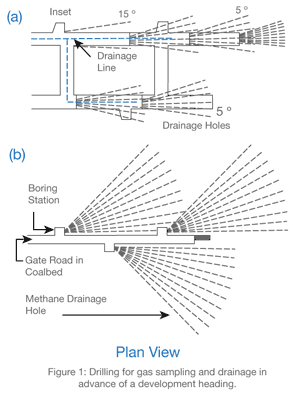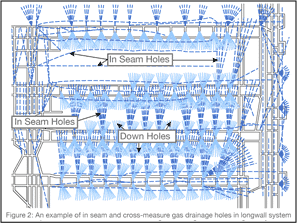Gas Drainage
Removal of gas from the coal seam and surrounding strata has
proven to be an effective method in reducing or eliminating outbursts.
The benefits of gas drainage are:
- Gas given off from the virgin coal is reduced so that gas percentage in intake airways and at working faces are kept within statutory limits and coal production rates are not governed by gas emission rates. This is achieved by degasification of coal prior to mining, i.e., pre-drainage.
- Gas given off from the adjacent strata, mainly the lower coal seams after extracting an area of coal,
is controlled so gas percentages in return airways are maintained below statutory limits. This is achieved by
drainage from adjacent strata after mining, i.e., post drainage.
- A reduction in the intensity of outbursts of coal and gas.
Gas drainage in coal mines can be either by
- mine ventilation system, or
- drilling technique
The drainage by mine
ventilation is normally used in mines with relatively low coal gas
content. However, in coal deposits with high gas content beyond threshold
limits, gas drainage can be carried out by drilling boreholes. Drainage
by bore hole drilling can be carried out either from the surface
or from underground. In either case the drainage of gas can be carried
out either prior to mining- called “pre-drainage” or
after mining of the coal seam- called “post drainage".
Surface Drilling
 Pre drainage of coal seam and surrounding deposits can be carried out by drilling holes from the surface and
even prior to the commencement of the mining operations. Holes drilled can be vertical, angled (Ray 2004) or
deviated as per need. In seam drilling can also be carried out from the surface by deviated drilling.
See figure opposite.
Pre drainage of coal seam and surrounding deposits can be carried out by drilling holes from the surface and
even prior to the commencement of the mining operations. Holes drilled can be vertical, angled (Ray 2004) or
deviated as per need. In seam drilling can also be carried out from the surface by deviated drilling.
See figure opposite.
Surface drainage generally involves drilling boreholes on a grid pattern from the surface to the coal seam.
The spacing between the holes varies between 250-500m. The location of the boreholes is influenced by surface
topography and ease of access to the drill site. Above all it can also be influenced by the angle of drilling.
Currently the grid spacing of the surface holes is widened significantly because of borehole deviation and branching.
Hydrofracing and deviated drilling are also carried out from the surface. Drilling from the surface can also be carried
out for post drainage. The effectiveness of post drainage is influenced by the competency of the overburden
stratification. The longwall extracted areas can be efficiently sealed off after
completion of the extraction process. The exposed cavities and/or goaf areas form ‘free gas’ reservoirs that
can be extracted by post-drainage techniques at a predetermined controlled rate. To avoid dilution of high percentage
methane behind the seals, the quantity of captured gas should be in equilibrium with gas desorption rate from the
strata gas sources. Part of the gas usually leaks directly to the ventilation system, however, the majority of high
percentage methane could be recovered by goaf gas drainage systems. The extracted gas can be diffused into the
ventilated mine workings or transported by a methane drainage network to the surface for utilisation or controlled
exhaustion to the open atmosphere. The diameter of surface holes is 150 to 300 mm, which depends on working seam
depth, gas and mining conditions as well as the source of gas transportation (suction or free flow - buoyancy effect).
Underground Drainage
Underground drainage of gas can be carried out as pre drainage and post drainage and these include:
Local drainage ahead of the development headings:
Figure 1 above shows a typical method of drilling holes ahead of the roadway. These holes are drilled to
sample gas in advance of the developing coal face and extract any residual gas ahead of and adjacent to the proposed roadway.
Inseam gas drainage across the panel and along the panel:
Figure 2 below shows typical drilling patterns used in the inseam drainage of a panel. The extent of the drill hole density,
drill pattern and drill fan orientation with respect to the panel direction is dependent upon the coal permeability, coal
gas make, gas composition, ground principal stress direction, coal cleat orientation and lead time until mining.
Holes, typically 96 mm in diameter, are normally drilled in advance of the working face, from gate roads or main headings
to dewater and degas the coal over time intervals of 3 -18 months, depending on virgin gas content, permeability and hole
spacing. Holes are typically 250-400m in length but can reach over 1500m if required. The coal gas is drained of the coal
either by its natural gas pressure or with the aid of vacuum pumps.
Cross measure drilling, below or above the working seam:
This type of drilling practice is primarily focused on controlling and managing gas, which has the potential to migrate
into the mine workings. Holes are drilled into the floor and/or roof of the coal seam being worked and in advance of the
longwall coal being extracted. These holes are usually inactive or dormant prior to longwall extraction and only start to
liberate significant gas flow as the floor and/or roof fractures with the extraction of the coal. Figure 2 above shows
the cross measure holes
(in light blue) drilled to the floor of the mined coal seam, intersecting the gas horizons and coal
seams beneath the mined seam.
